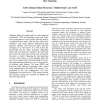Free Online Productivity Tools
i2Speak
i2Symbol
i2OCR
iTex2Img
iWeb2Print
iWeb2Shot
i2Type
iPdf2Split
iPdf2Merge
i2Bopomofo
i2Arabic
i2Style
i2Image
i2PDF
iLatex2Rtf
Sci2ools
DSN
2003
IEEE
2003
IEEE
Evaluation of Fault Handling of the Time-Triggered Architecture with Bus and Star Topology
Arbitrary faults of a single node in a time-triggered architecture (TTA) bus topology system may cause error propagation to correct nodes and may lead to inconsistent system states. This has been observed in validation work using software implemented fault injection (SWIFI) and heavy-ion fault injection techniques in a TTA cluster. In a TTA system, the membership and the clique avoidance algorithms detect state inconsistencies and force the nodes that do not have the same state with the state of majority of nodes, to restart. Changing the interconnection structure of the cluster to a star topology allows the use of star couplers that will isolate faults of a node, thus guaranteeing consistency, even in the presence of arbitrary node failures. The same SWIFI and heavy-ion fault injection experiments that caused error propagation in bus-based TTA clusters, were performed in the star configuration. No error propagation was observed in a TTA system with the star topology during the execut...
| Added | 04 Jul 2010 |
| Updated | 04 Jul 2010 |
| Type | Conference |
| Year | 2003 |
| Where | DSN |
| Authors | Astrit Ademaj, Håkan Sivencrona, Günther Bauer, Jan Torin |
Comments (0)

